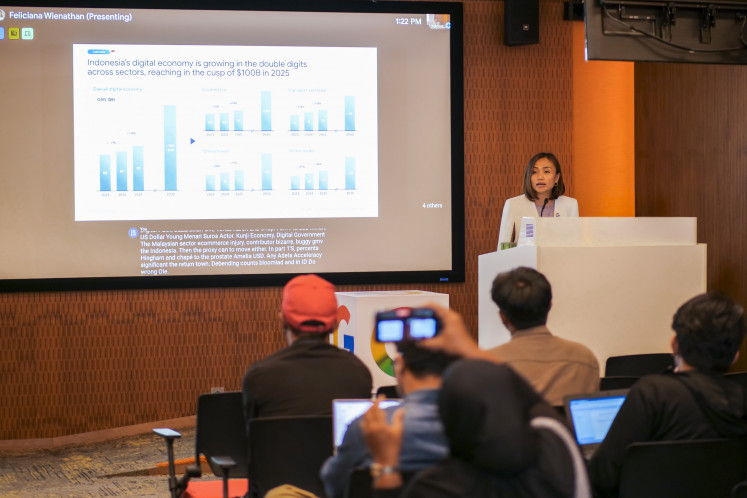Popular Reads
Top Results
Can't find what you're looking for?
View all search resultsPopular Reads
Top Results
Can't find what you're looking for?
View all search resultsBuilding to last protects forests
Saved: Using reclaimed timber in construction protects forests from logging
Change text size
Gift Premium Articles
to Anyone
Saved: Using reclaimed timber in construction protects forests from logging.
Growing at just two millimeters per annum, Kalimantan’s ironwood trees, locally called ulin, take a century to achieve just 20 centimeters in diameter.
This staggeringly slow-growing tree lives for more than a millennium, but mature trees are rare in forests and unfeasible as plantation timber.
This densely compacted growth makes ulin one of the hardest timbers in the world. It is unbeatable as a building material and in high demand in Indonesia’s rapidly growing regions, including Bali. And therein lies the dilemma, as ulin is now under threat of extinction.
The harvest of ulin for export from Kalimantan has been tightly limited to just a few licensed companies in recent years. New wood is pretty much only allowed for sale within Kalimantan.
Supporting the ban on newly extracted ulin exports is conservationist and former Sydney Rainforest Action Group member Alex Ryan of Lotunduh, Bali.
She and her Kalimantan-bred husband, Yoga Sofyar, have since 2009 been finding ways to have certified recycled ulin available as a construction timber, while also raising awareness of how current laws on ulin protection are being circumvented for illegal trade.
Ryan alleges ulin, recently logged from primary forests for use in Kalimantan, is being crafted into boats that are sailed to China where they are then dismantled and the precious timber re-milled for sale to Europe and the US. To address this, Ryan calls for a blanket ban on any further logging of ulin from forests.
“I have heard of people building ships of ulin — these are not fitted out and the timber are left in a state where they can be re-milled into products in China for export to Europe and the US. In other words, people are taking new ulin from forests and turning it into boats for the specific purpose of smuggling newly logged ulin out of Kalimantan and into China illegally,” Ryan said.
Ulin is a protected tree species whose harvest is mainly allowed for construction in Kalimantan; off island exporting of new wood is restricted to a handful of licensed companies or to business’ dealing in genuinely recycled or reclaimed timber, explains Ryan, who lived for several years in Samarinda in east Kalimantan, working on forest conservation projects.
Recycled: These tongue in groove floorboards of precious ulin have been re-milled from a demolished building in Kalimantan.
Aside from boat construction as a maneuver to flout Indonesia’s laws on ulin protection, Ryan says Kalimantan is currently awash with unnecessary demolitions of structures simply to extract ulin.
“Inter-island and international trade in ulin is currently restricted to a very few licensed companies. Theoretically the trade in new wood ulin should be very small. So to get around this in Kalimantan, structures that still have many decades of life left are being demolished and replaced with newly logged ulin, because the regulations do not cover local trade [in the timber],” says Ryan, pointing out that buildings are essentially being demolished for their wood, while new buildings are going up to soon be knocked down. Logging trucks are being driven through the gaping loophole in the protection law on ulin dealing in what is essentially newly extracted ulin under the guise of recycled wood.
This impacts not just the ancient forests of Kalimantan, that are daily being decimated for palm oil plantations or mining operations, but also people who are forest dependent, says Ryan. She points out the Dayaks of Kalimantan need ulin for many of their traditional medicines and ceremonies, such as for the carving of effigies for the dead.
“These people are now struggling to source ulin, so this loss of a traditionally important resource impacts their culture and religious practices,” says Ryan.
Due to the unscrupulous practices being undertaken to allegedly smuggle recently extracted ulin out of Kalimantan, Ryan believes it is time to call a halt to all ulin logging across the island. The timber is in great demand worldwide due to its A1 structural timber rating, a rating that means the timber will last on the ground for at least five decades. It is also extremely termite resistant with great strength, density and beauty.
“As a species listed on the International Union for Conservation of Nature [IUCN] Red List as threatened with extinction, ulin should no longer be extracted out of the Kalimantan forests. It has gotten to the point where ulin scarcity is impacting greatly on these forest dependent communities. I would say a complete ban on any future extraction of ulin from natural forests is needed,” says Ryan.
Despite protective laws on the wood, ulin is readily available in Bali. A drive along highways in the island’s south turns up several dealers of this timber that takes centuries to mature. These businesses advertise ulin roof shingles, picket fence posts, building beams and more. Few are willing to divulge the source of their ulin.
Ryan, with her recycled ulin business, Kaltimber, says she is aiming to teach customers how to tell the difference between ethically and unethically sourced ulin and to design structures for longevity — to apply the right wood for the job at hand to achieve the lowest re-build rate into the future.
Origins: Tags establish the origin of recycled wood, proving where and how they were sourced.
“One of the reasons we deplete our resources so quickly is because we don’t design in a clever way. If we can put longevity into the design phase, I believe there will always be a market for reusing, reclaiming and designing around the material’s original state. I know that is not always possible, but it is what I am trying to promote,” says Ryan, whose ulin stock has provable provenance with GPS locations, images of the original structure’s state and information on its prior owner in Kalimantan.
Selecting the right material for the application can determine whether that structure lasts 50 years or just a handful, says Ryan.
“Look at mirbau decks. Mirbau is cheap when you put it in, but it won’t handle the [weather] conditions. So at the end of the day with mirbau, you have timber that is extracted from natural forests in Papua, either illegally or destructively, as there are no mature mirbau plantations in Papua. So you buy the wood from forests where the forest management is dodgy or questionable at best, so this has social and environmental impacts, and you install mirbau decking that needs to be re-done in a few years, so it’s cheap at first, but how cheap really? So this is what we try to promote: Know the wood you buy, know where it comes from, know the impact it is having and then make an informed choice. Ask your supplier, ask the questions [on timber provenance] and if they don’t know tell them to find out or change suppliers,” says Ryan, stressing that new ulin should be almost unavailable in Bali or anywhere outside of Kalimantan under the existing regulations.
“The standing stocks of ulin left in natural forests in Kalimantan have been so drastically reduced through logging and land clearing that the national forestry department has enacted new regulations to control it’s trade,” says Ryan.
However, she says, the new regulations strictly controlling new wood sales while allowing the sale of recycled ulin have “ironically in some ways driven further the destruction of Kalimantan’s forests, because the legislation to protect has not gone far enough, because newly logged ulin can still be used in Kalimantan, so there is a ‘let’s send the old stuff out’ mentality, so the old wood is being sent to Bali or elsewhere and the newly logged ulin is replacing the timbers being sourced from unnecessary demolitions,” says Ryan of the manipulations undertaken that mock forest protection laws.
Ryan and her husband are currently establishing an information center within their recycled timber showroom to educate the public on forest protection and sustainable forestry practices, designing structures for longevity to reduce resource waste and build understanding of timber certification and provenance standards that are created to ensure healthy forests in the future.
— Photos by J. B. Djwan












